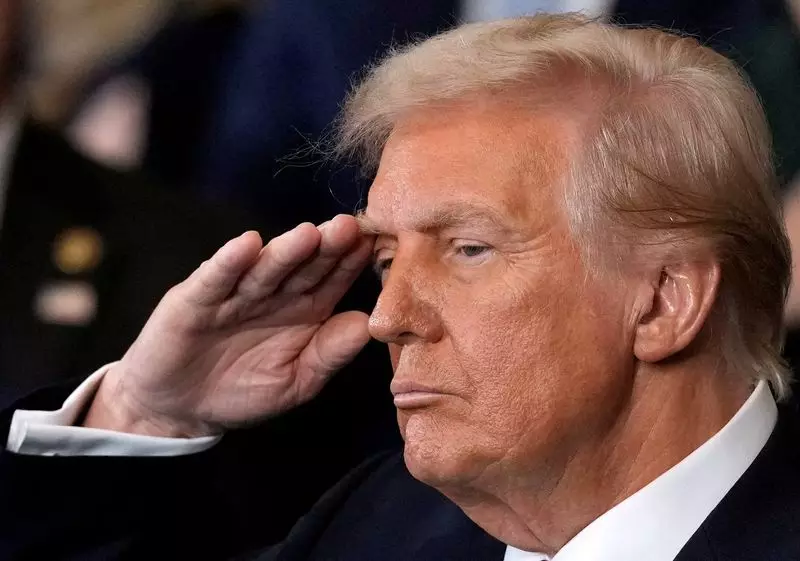In the early weeks of President Donald Trump’s first term, speculation surrounding his approach to international trade was rife. As markets braced for potential upheavals, a trade memo set to be released on a significant Monday was announced, providing a glimpse into Trump’s strategy. While the memo does not immediately impose tariffs, it directs federal agencies to rigorously assess U.S. trade relations, particularly with major partners like China, Canada, and Mexico.
The financial world reacted positively to this news—unlike the initial dread of wide-ranging tariffs that many anticipated. The U.S. dollar experienced a marked decline against several key currencies, reflecting a sense of relief among traders who had feared aggressive monetary measures. In particular, the euro, Canadian dollar, Mexican peso, and Chinese yuan saw notable increases against the dollar. The MSCI index for global stock markets also showed significant gains that day, signifying a temporary sense of stability in global financial markets.
Such market dynamics play an essential role in influencing the prevailing economic atmosphere. The relief rally was indicative of investor sentiment that a more methodical and potentially less disruptive approach to trade might be on the horizon. Overall, while some analysts speculated that Trump might use emergency powers for swift trade actions, the memo hinted that he was instead opting for a more calculated evaluation of existing trade arrangements.
In his inaugural address, Trump maintained his commitment to revamping the U.S. trade system, emphasizing the protection of American workers and families as a primary goal. He reiterated the need for an “External Revenue Service,” a novel agency aimed at maximizing revenue from tariffs and duties against foreign countries. By framing this initiative around benefiting American citizens rather than burdening them with taxes, Trump sought to reroute the narrative of international trade back into the hands of the U.S.
This focus on American interests ties back to Trump’s historical rhetoric during his campaign, where he threatened steep tariffs, targeting a wide range of imports. His intention to specifically hold Canada and Mexico accountable for their immigration and drug trafficking policies reflects a broader strategy to leverage trade negotiations for more than just economic gain.
The forthcoming trade memo underscores a commitment to scrutinizing countries’ adherence to trade agreements and their compliance with established regulations. It emphasizes bringing attention to persistent trade deficits and perceived unfair trading practices. By focusing on China, Canada, and Mexico, the memo positions these nations as pivotal players in an evolving trade landscape that Trump’s administration aims to reshape.
After the tumultuous trade war with China, where tariffs were imposed on both sides, this reassessment represents a continuing trend in U.S.-Chinese relations. Trump’s previous administration negotiated a landmark deal with China, which required significant purchases of U.S. exports but was disrupted by the COVID-19 pandemic leading to questions of compliance. The new approach seems to involve revisiting these agreements to ensure that commitments are being honored.
The Strategic Use of Investigations
In contrast to a quick implementation of tariffs, the planned investigations signify a potential shift in Trump’s methodology. The memo indicates reliance on existing legal frameworks, such as the Section 232 national security statute and Section 301 provisions addressing unfair trade practices, to address issues methodically. This pivot away from immediate enforcement measures may seek not only to quell market fears but could also reflect advice from trade experts who warned about the broad ramifications of hasty tariffs.
Past experiences have shown how such investigations can extend for months, often leading to significant delays in the enforcement of policies that impact international trade. Nevertheless, trade analysts expect that Trump’s administration will still pursue comprehensive tariff actions as part of its overarching economic strategy, emphasizing a long-term vision.
Reflecting on Trump’s previous term, where a series of tariffs were leveraged against various countries, particularly China, illustrates the administration’s complex relationship with trade policy. The memo appears to strike a balance between decisive action and thoughtful negotiation. As Trump continues to assert the importance of reshaping global trade dynamics to favor U.S. interests, the challenge will lie in implementing strategies that do not overly disrupt established trade networks while addressing domestic priorities.
Trump’s methodical approach to trade may reflect a calculated recalibration aimed at sustaining economic growth and fostering better relationships with key partners, albeit under the umbrella of a nationalist agenda. As this chapter in U.S. trade policy unfolds, it will be crucial to monitor how these initial directives translate into tangible outcomes in both domestic and international contexts.

